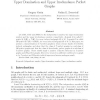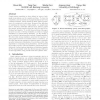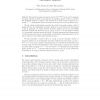3211 search results - page 47 / 643 » On the Grundy Number of a Graph |
DM
2000
13 years 7 months ago
2000
Erdos proved that there are graphs with arbitrarily large girth and chromatic number. We study the extension of this for generalized chromatic numbers. Generalized graph coloring d...
DM
1998
13 years 7 months ago
1998
Let β(G), Γ(G) and IR(G) be the independence number, the upper domination number and the upper irredundance number, respectively. A graph G is called Γperfect if β(H) = Γ(H),...
CORR
2012
Springer
12 years 3 months ago
2012
Springer
Graph pattern matching is often defined in terms of subgraph isomorphism, an np-complete problem. To lower its complexity, various extensions of graph simulation have been consid...
IWOCA
2009
Springer
14 years 2 months ago
2009
Springer
: We present an improved upper bound of O(d1+ 1 m−1 ) for the (2, F)-subgraph chromatic number χ2,F (G) of any graph G of maximum degree d. Here, m denotes the minimum number of...
STACS
2010
Springer
14 years 2 months ago
2010
Springer
Abstract. A Boolean function on N variables is called evasive if its decision-tree complexity is N. A sequence Bn of Boolean functions is eventually evasive if Bn is evasive for al...



